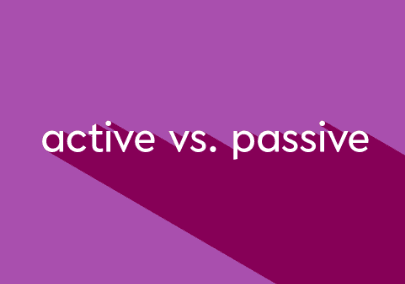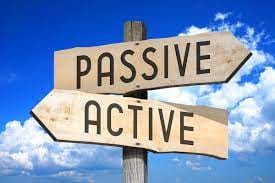Understanding the Dynamics of Passive vs Active Voice
Contents

Let's consider an example: "Ravi made the tea" (active) versus "The tea was made by Ravi" (passive). Both sentences convey the same fact, but the active voice feels more immediate and engaging.
In many professional contexts in India, using active voice shows you as decisive and clear-headed, while passive voice can suggest diplomacy or tact.
With this blog post, we'll explore passive vs active voice, guiding you towards their correct usage with practical tips and real-life examples.
Understanding Active Voice
Active voice is a grammatical term denoting a sentence structure where the subject performs the action denoted by the verb. For example, "Vinny cooks biryani". Here, Vinny (the subject) is doing the action of cooking.
Active voice is commonly used in everyday conversations, storytelling, and professional communication.
When engaging in spoken English, using active voice can make your speech clearer and more direct. For more insights on grammatical voices in English, this video on Clapingo's YouTube channel.
Understanding Passive Voice
On the other hand, passive voice is when the object of an action becomes the subject of a sentence. Let's transform our previous example into passive voice: "Biryani is cooked by Vinny." Here, biryani (the object) has become the focus point.
Passive voice is frequently used when we want to highlight the action rather than who performed it or if we don't know who did it. For instance, if you come across a beautiful mural in your city and don't know the artist, you might say: "A stunning mural was painted on this wall."
Proficiency in both active vs passive voices adds variety to your English, making it richer and more nuanced.
It's important to note that neither voice type is 'better' than the other. They simply serve different purposes and add diversity to the language.
Differences Between Passive and Active Voices

Let's understand the two voices and their key differences.
Active Voice | Passive Voice |
The subject performs the action. | The subject receives the action. |
Emphasizes who is doing the action. | Focuses on the action or what is acted upon. |
Here is an example:
Active Voice: The teacher will mark the papers.
Passive Voice: The papers will be marked by the teacher.
In this example, 'the teacher' switches from being an active doer to a mere mention in the passive voice.
Understanding passive vs active voice examples like this can greatly improve your English speaking skills.
Identifying When To Use Passive Or Active Voices
To master passive vs active voice, it's essential to understand when each should be applied. Let's look at some tips using examples.
Assertiveness: Use active voice when you want to sound more assertive or direct. It's often used in business meetings or presentations for clarity and decisiveness. For instance, "I completed the project yesterday."
Object Focus: Choose passive voice when the focus is on the object or action rather than who performed it. It's commonly used in scientific reports or news articles where the action is more important than the actor. For example, "The project was completed yesterday."
Unknown Actor: If you don't know who performed an action or it isn’t important, use passive voice. When narrating a story, this can add a sense of mystery. For instance, "The window was shattered."
Formality: Active voice can make your language sound more informal and conversational, while passive voice lends a formal tone to your sentences.
Remember that both voices have their place in English conversation and writing but choosing between passive vs active speakers wisely will ensure your communication is clear and effective!
Exercises for Practising Passive and Active Voices
Here are some exercises to help you practice passive and active voices:
Sentence Completion
She was praised by the boss for her diligence. (Passive)
The manager _______ her for her hard work.
Error Detection
The letter was written by John yesterday.
John the letter wrote yesterday.
Sentence Transformation
Neha prepared a wonderful presentation. (Active)
A wonderful presentation ________ by Neha. (Passive)
Solutions:
1. The manager praised her for her hard work.
2. John wrote the letter yesterday.
3. A wonderful presentation was prepared by Neha.
Consistent practice can significantly improve your proficiency in using active and passive voices.
How Clapingo Can Assist in Mastering Passive Vs Active Voices
Mastering the difference between passive and active voices can seem daunting. However, with Clapingo's one-on-one personalised coaching sessions, this complex grammatical concept becomes more accessible. Native English-speaking tutors understand the intricacies of voice usage and can guide you through practical examples. Plus, the flexible scheduling of sessions ensures a learning pace that suits your convenience.
Key Takeaways
In this journey through English grammar, we've covered passive vs active voice.
An active voice, as you've learnt, constructs sentences where the subject performs an action. For example, "Ria eats an apple." Passive voice switches the order of a sentence to "Ria eats the apple."
Understanding and correctly using passive vs active voice can enormously enhance your fluency in English, whether you're trying to discuss passive vs active stock ownership or exploring passive vs active income avenues.
Remember, every step towards mastering English grammar is a step towards self-empowerment. Start your English learning journey with Clapingo.
FAQs
1. What is the difference between passive and active voice?
In English grammar, the distinction between passive and active voice refers to the structure of a sentence. In the active voice, the subject performs the action, like "Rahul played cricket." Here, Rahul is acting. However, in a passive sentence, the subject is acted upon: "Cricket was played by Rahul."
2. When should I use passive versus active voice?
Active voice makes your sentences direct and engaging, it's generally preferred for clarity and brevity. Example: "The cat caught the mouse." However, passive voice can be useful when you want to emphasize the action rather than who is doing it. Example: "The mouse was caught by the cat." Remember, both have their roles in language.
3. What does passive vs active learning mean?
Active learning involves actively engaging with the material—like participating in a conversation or writing an essay in English. You're participating directly in your learning process. On the other hand, passive learning involves absorbing information without interacting—like watching an English movie or reading a book without practicing speaking or writing from it.
Comments
Your comment has been submitted successfully!